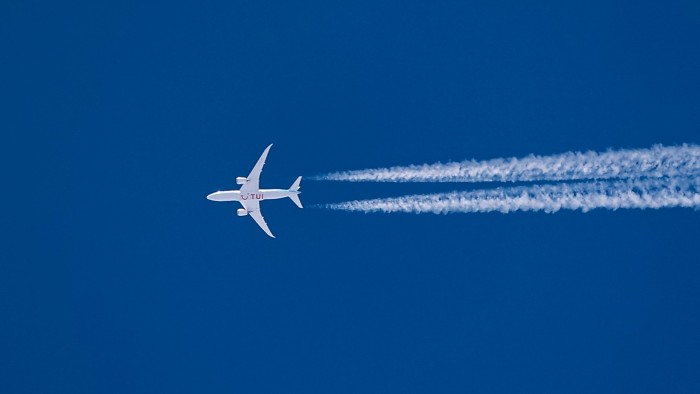Stay informed with free updates
Simply sign up to the Airlines myFT Digest — delivered directly to your inbox.
European airline emissions are on course to exceed pre-pandemic levels this year, underlining the aviation industry’s struggle to decarbonise as it lobbies Brussels for looser green rules.
Carbon dioxide emissions from flights by European airlines are set to reach 195.2mn tonnes this year, according to forecasts from environmental group Transport & Environment, 4 per cent above 2019 levels.
That volume would be above the 187.6mn tonnes produced by the sector last year, when the industry made a near complete recovery to pre-pandemic levels of flying according to T&E.
European airlines have collectively committed to reaching net zero by 2050 through a mix of new technologies, notably alternative fuels, as well as carbon trading schemes and more efficient aircraft, engines and air traffic management.
But carriers have complained that sustainable aviation fuel (SAF) is too expensive, and not enough is being made, and last month urged the EU to soften some of its environmental rules.
The chief executives of four of the region’s largest airlines, including Ryanair and Lufthansa, have said the EU will probably need to delay rules that require fuel companies to provide airlines with an increasing amount of SAF each year.
The airlines said that while the 2 per cent required this year was achievable, a rise to 6 per cent by 2030 would be impossible given current levels of production, and low investment in the new fuels by oil majors. The UK’s separate sustainable fuel rules will require 10 per cent by 2030, which the airlines also said would be hard to achieve,
The bosses have also called for the EU and UK’s flagship carbon pricing schemes for aviation, which levy charges on carbon emitted on flights within Europe, to be eased and brought in line with a cheaper global standard.
In a statement the EU said that the rising number of flights “underscores the need for action to reach our climate commitments,” adding: “Aviation needs to do more.”
Airlines produce around 4 per cent of the bloc’s total greenhouse gas emissions, with the jump recorded by T&E coming as travel has boomed since the end of the Covid-19 pandemic. Eurocontrol, the air traffic management body, has found that many EU countries already have air traffic above 2019 levels and expects that flights covering the whole of Europe will surpass 2019 in the first half of 2025.
Brussels is currently reviewing the scope of its emissions trading scheme (ETS), the main EU-wide tool for reducing emissions. The scheme currently only charges airlines for emissions on flights within Europe.
Flights outside the region are exempted, and instead subject to the international Corsia offsetting scheme, which charges much less to pollute. This means the most polluting long-haul flights pay less to emit carbon than shorter flights within Europe. The T&E data showed that the route with the highest emissions in 2024 was London to New York, which was responsible for 1.4mn tonnes of CO₂.
The commission said that if Corsia was not strengthened, then it could propose to extend the scope of the ETS to flights departing the EU to other destinations, although analysts have said this was likely to meet fierce resistance from countries such as the US. T&E estimated that expanding the ETS to all flights would have cost airlines about €7.5bn last year.
Krisztina Hencz, aviation policy manager at T&E, said the review of the EU’s carbon markets was a chance to “rectify a loophole” and expand to include all airline emissions. “The sector continues to dodge the true cost of its pollution,” she said.
Airlines4Europe, the industry’s trade group, said the industry in Europe was “leading the way in decarbonising aviation”. Pushing for even tighter restrictions on European airlines may score headlines, but it does little to cut global aviation emissions — and risks undermining Europe’s leadership in clean aviation.”
